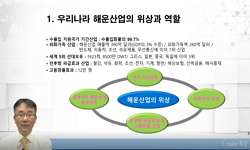우리나라에 있어서 물류의 중요성에 대하여 그 의미를 부여하게 된 것은 오래되지 않았다. '80년대 초에 물류관리라는 개념이 제3의 이윤 창출의 원천이라는 명목하에 기업에서 인식하게 되...
http://chineseinput.net/에서 pinyin(병음)방식으로 중국어를 변환할 수 있습니다.
변환된 중국어를 복사하여 사용하시면 됩니다.
- 中文 을 입력하시려면 zhongwen을 입력하시고 space를누르시면됩니다.
- 北京 을 입력하시려면 beijing을 입력하시고 space를 누르시면 됩니다.
우리나라 소화물일관수송의 효율적 물류네트웍 구축방향에 관한 연구 : A사의 사례를 중심으로 = (A) Study for establishing an efficient direction of domestic logistics network on throygh delivery system of small package
한글로보기https://www.riss.kr/link?id=T7123997
- 저자
-
발행사항
서울 : 연세대학교 경영대학원, 1998
-
학위논문사항
학위논문(석사)-- 연세대학교 경영대학원: 경영학과 1999. 2
-
발행연도
1998
-
작성언어
한국어
- 주제어
-
KDC
325.77 판사항(4)
-
DDC
658 판사항(20)
-
발행국(도시)
서울
-
형태사항
vi, 83p. : 삽도 ; 26cm
-
일반주기명
참고문헌: p. 77-80
- 소장기관
-
0
상세조회 -
0
다운로드
부가정보
국문 초록 (Abstract)
우리나라에 있어서 물류의 중요성에 대하여 그 의미를 부여하게 된 것은 오래되지 않았다. '80년대 초에 물류관리라는 개념이 제3의 이윤 창출의 원천이라는 명목하에 기업에서 인식하게 되었고,'80년대 중반 이후 '90년 대 초에 이르러서 비로소 일반 소비자를 대상으로 물류 합리화를 추구하기 위한 연구와 노력이 시작되었다.
물류 합리화를 추구하기 위한 직접적인 계기는 환경의 변화에 기인한다. 즉, 세계가 하나의 시장이 됨으로써 기업간의 경쟁이 심화되고, 또한, 통신 수단의 발달 등으로 소비자의 욕구가 다양화·다원화됨으로써 이와 관련된 생산·판매·유통·물류 등 제반 분야에서 체제 전환이 불가피하게 되었다.
따라서, 이러한 체제 전환의 일환으로서 도입이 된 소화물일관수송은 막대한 투자가 선행되어야 하는 장치산업이면서 운영 합리화를 위해서는 정부의 지원이나 기업 스스로의 연구 개발 노력이 절실한 실정이다.
본 연구에서는 소화물일관수송의 운영 합리화를 위한 하나의 과제로서 우리나라 특성에 적합한 물류네트웍 구축방향에 대하여 고찰해 보았다.
우선 소화물일관수송에 대한 서비스제도 도입 의의와 특성, 운송체계등에 대한 기본적인 고찰을 통하여 물류네트웍이 가지는 역할과 중요성에 대하여 파악해 본 결과, 소화물일관수송 사업을 하고 있는 기업 입장에 있어서는 고객에 대한 서비스 제고를 통한 경쟁 우위 확보와 원가 절감을 기할 수 있는 차원에서 그 중요성이 부각되고 있으며, 소비자 입장에 있어서는 과거 소화물운송체계에 비해 신속성, 안정성, 편의성 등의 혜택을 받을 수 있다는 측면에서 그 중요성이 있는 것으로 나타났다.
이에 따라 물류네트웍의 기본 요소인 노드(Node)와 차량 등 하드웨어 측면과 정보시스템과 링크(Link)계획 등 소프트웨어 측면을 적절히 확보하고, 이를 상호 유기적으로 시스템화하여 효율성과 효과성을 동시에 추구하는 방향으로 구축해야 한다.
물류네트웍을 구축하기 위해서는 여러 가지 변수와 요인을 적용하여 검토할 수 있지만, 본 연구에서는 운영 비용, 권역별 화물의 양과 흐름 및 인구의 분포에 따른 분석을 하여 구축 방향을 결정하였다. 분석 결과, 운영 비용에 있어서 노드비용이 링크비용보다 상대적으로 높기 때문에 운송 경로상에 터미널을 경유하여 집하에 의한 적재율 향상을 피하는 것이 오히려 총비용을 증가시키므로 Hub & Spoke 네트웍보다는 Point to Point 네트웍을 형성하는 것이 유리한 것으로 나타났다.
따라서, Point & Point 네트웍을 구축하기 위한 방향으로서, 첫째, 전국적으로 중계터미널을 서울 및 수도권, 부산 및 영남권, 광주 및 호남권, 대전 및 중부권의 4개 권역에 배치해서 간선 운송 체계를 구축해야 한다.
아울러 중계터미널은 엄청난 양의 목적지가 서로 다른 개별 화물을 신속하게 분류할 수 있는 능력이 있어야 한다. 따라서, 대규모 부지를 확보하고 자동분류기를 설치하여 분류 작업의 능률을 제고시킴으로써, 차량의 대기 시간 감축과 작업인력의 생력화가 가능토록 해야 한다.
둘째, 각 권역별 중계터미널을 중심으로 집배송 터미널이 위성 형태처럼 배치되어야 한다. 즉, 집배송 터미널은 중계터미널과의 연계와 Door까지의 집배송을 신속하고 원할하게 하기 위하여 운송거리와 배송 리드타임(Lead time) 등을 고려해서 주요 거점마다 설치토록 해야 한다.
이러한 하드웨어적 요소를 구축함과 동시에 이를 효율적으로 운영하기 위해서 바코드시스템, 화물추적시스템 등 전산시스템을 구비해야 하며, 또한, 터미널과 터미널간, 터미널과 Door간의 운송체계를 과학적인 방법으로 스케줄링(Scheduling)해야만 한다.
결국, 우리나라에 있어서 소화물일관수송의 물류네트웍은 경부축과 호남축을 중심으로 하는 Point to Point 시스템을 구축하는 방향으로 나아가는 것이 바람직하다.
다국어 초록 (Multilingual Abstract)
It was not long ago when the meaning of logistics got its momentum with importance in Korea. Industries became to recognize the concept of logistics management in the name of creating a 3^(rd) profit out of it in the early 80's and started to resear...
It was not long ago when the meaning of logistics got its momentum with importance in Korea. Industries became to recognize the concept of logistics management in the name of creating a 3^(rd) profit out of it in the early 80's and started to research and practice it to the early 90's from the mid 80's.
The direct motivation to get the efficient logistics comes from the changes of business environment. That is, industries have been struggling for survival more competitively than ever between them as the world is being united into one global market and they have no choice but to revamp their past paradigm relating to the whole business activities such as producing, sales, distribution and logistics to meet the customers' diversified needs.
Therefore, being introduced as a part of change against the past practices, through delivery service of small package is a kind of a installation industry which requires a great amount of investment in advance. At the same time, it is highly requested to get the necessary support from the level of government and to focus their endeavors on R&D in terms of operational efficiency.
This study is aiming at establishing the efficient directions of logistics network which can be applied appropriately under the peculiar situation in Korean industry as a subject to be discussed.
Above all, based on the result of research for its role and importance through the basic study on the intent of introduction and peculiarity rendered by through delivery service of small package, we can reach the conclusion that the importance of through delivery service has been emerging by way of getting comparative competitiveness in maximizing customers' satisfaction from the point of industries. On the other hand, customers have become to recognize its importance for the favorable benefits such as speed, security and convenience.
So, it is highly requested that through delivery service of small package should retain the hardware such as nodes and transportation means as well as adequate software such as information system to include link planning. These should be systematically organized for the sake of efficiency and utility at the same time.
In order to establish a logistics network, this study is based on the analysis of operational costs, quantities and flows of the regional movements even though we can employ a lot of variations to be reviewed. With the result of this study, we arrive at the conclusion that Point to Point network is more efficient than Hub & Spokes because Hub and Spokes network increases overall costs due to higher capital investment on nodes comparing to links from the standpoint of operational costs though it enables to improve loadibility by consolidating the shipments through the designated terminal on their way.
Accordingly, at first, relay terminals set up in the major regions which can be classified by their geographic locations as a way of establishing Point to point network ; Seoul and metropolitan areas, Kwangju and Honam, Taejon and Choongchung.
In addition, a relay terminal should have the ability to segregate the great deal of individual packages with various destinations in a speediest manner to increase its productivity. That is why a relay terminal should be built on a large scale of estate and equipped with automatic sorter so that waiting time and man power can be streamlined.
Second, pick-up and delivery terminals should be located and oriented towards the designated relay terminal like satellite. In other words, for the purpose of pick-up and delivery, a relay terminal should be located at the every major node in conjunction with distance and delivery lead time to perform the speediest delivery to consignee's door via a relay terminal.
In order to establish and operate those required hardware at the same time, the computer systems including barcoding and tracing functions should be installed at each terminal and van planning also should be done in accordance with scientific method for the transportation means and routes between terminal terminal and terminal door.
In concluding, through this study, it is recommended that the logistics network for through delivery service of small package should be based on Point to point system linking Kyungbu line and Honam line.
목차 (Table of Contents)
- 목차 = ⅰ
- 표목차 = ⅲ
- 그림목차 = ⅳ
- 국문요약 = ⅴ
- 제1장 서론 = 1
- 목차 = ⅰ
- 표목차 = ⅲ
- 그림목차 = ⅳ
- 국문요약 = ⅴ
- 제1장 서론 = 1
- 제1절 연구의 배경 및 목적 = 1
- 1. 연구의 배경 = 1
- 2. 연구의 목적 = 2
- 제2절 연구의 개요 = 3
- 1. 연구의 방법 = 3
- 2. 연구의 범위 = 4
- 3. 연구의 구성 = 5
- 제2장 소화물일관수송의 기본적 고찰 = 6
- 제1절 소화물일관수송 서비스제도 도입 의의 및 용어의 정의 = 6
- 1. 소화물일관수송 서비스제도 도입 의의 = 6
- 2. 용어의 정의 = 8
- 제2절 소화물일관수송의 특성 = 10
- 제3절 소화물일관수송의 운송 및 요율체계 = 12
- 1. 운송체계 = 12
- 2. 요율체계 = 15
- 제3장 소화물일관수송 물류네트웍 구성에 관한 고찰 = 16
- 제1절 소화물일관수송 물류네트웍의 역할 및 중요성 = 16
- 1. 소화물일관수송 물류네트웍의 역할 = 16
- 2. 소화물일관수송 물류네트웍의 중요성 = 17
- 제2절 소화물일관수송 물류네트웍 구성요소 분석 = 20
- 1. 화물터미널의 입지 분석 = 20
- 2. 자동분류기(Auto Sorter)의 도입 = 23
- 3. 바코드(Barcode)시스템의 적용 = 25
- 4. 정보시스템의 구축 = 28
- 5. 수송수단 = 31
- 제4장 소화물일관수송 물류네트웍 구축에 따른 문제점 및 구축 사례 = 33
- 제1절 소화물일관수송 물류네트웍 구축에 따른 문제점 = 33
- 1. 화물터미널 확보에 따른 문제점과 개선방안 = 33
- 2. 화물자동차의 도심운행에 대한 문제점과 개선방안 = 38
- 제2절 소화물일관수송 물류네트웍 구축 사례 = 40
- 1. Hub & Spoke 물류네트웍의 특징 및 사례 = 40
- 2. Point to Point 물류네트윅의 특징 및 사례 = 43
- 제5장 소화물일관수송 물류네트웍 최적 구축방향 = 47
- 제1절 운송경로 결정을 위한 해법을 중심으로 한 네트웍 구축방향 = 47
- 1. 입력 데이터 = 47
- 2. 기본가정 = 48
- 3. 풀이과정 = 51
- 4. 분석 결과의 해석 = 55
- 5. A사의 소화물일관수송 네트웍에의 적용 = 59
- 6. 분석결과에 따른 결론 = 61
- 제2절 권역의 구분에 따른 물류네트웍 구축방향의 결정 = 62
- 1. 권역의 구분 = 62
- 2. 중계터미널 네트웍 구축 방향 = 64
- 3. 집배송터미널 네트웍 구축 방향 = 66
- 제6장 결론 = 74
- 참고문헌 = 77
- ABSTRACT = 81












